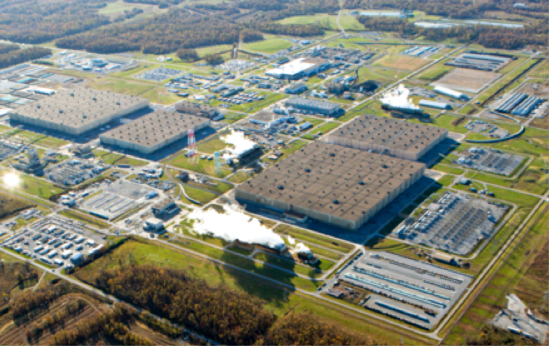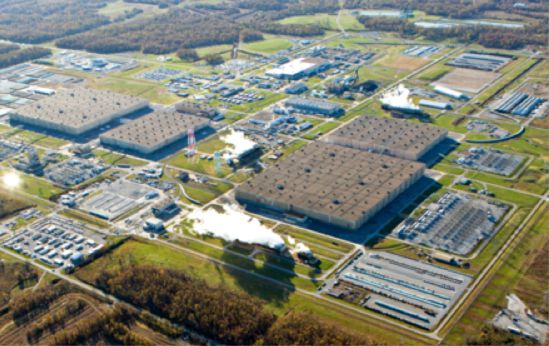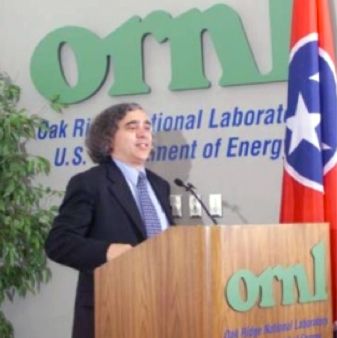

Neighbors for an Ohio Valley Alternative
By Geoffrey Sea
[Read Part I, Part III and Part IV of this series]

Inconsistent statements about the exact timing of the shutdown are due to confusion among the major players, because closure of a gaseous diffusion plant is a costly and complicated business, and neither USEC nor DOE has the resources or the plan to know exactly how this inevitability is going to happen. According to USEC, “the company will begin ceasing uranium enrichment at the end of May.”
The scandal of the situation is that, despite a very long lead-up to the inevitable plant closure (termination notices to employees were sent in December of 2011), no party moved to make detailed plans for the power-down, as DOE and the privatized USEC Inc. engaged in mutual extortion ploys over timing, bill payment and where the political blame for job loss could be cast. In the stalemate, DOE funding for the major work of powering down the enormous facility was put off until the 2014 fiscal year, at least five months after the power-down will actually occur. This insures a dirty procedure with the diffusion cells not evacuated of process gas.
On May 26, after the link to my article was widely circulated and the failure of an extension made headlines, a flurry of email communications among west Kentucky community leaders transpired, which included a terse statement by Paducah mayor Gayle Kaler: “Our priority as a community is first and foremost demanding clean up dollars. We cannot accept a dirty shut down.”
An honorable sentiment, but a dirty shutdown it shall be, not only because of the five month funding gap, but because all DOE discretionary dollars were pumped into saving USEC from immediate financial collapse—up to half a billion dollars in the past few years alone. And that money is mostly gone from the corporate coffers in the form of Gigantor salaries for USEC upper management. As his company sunk in the nuclear muck, CEO John Welch pulled down a cool $6.5 million salary in 2011 alone. If nothing else of energy consequence has come from privatized USEC, the super-speed siphon of funds from the U.S. Treasury to the private accounts of USEC corporate agents truly has been atomic-powered.
The Power-Down Gap
Even if the five month gap were bridged by some ungodly miracle of Mitch McConnell, it would not avert a dirty power-down at Paducah. That’s because William A. Murphie, manager of DOE’s Portsmouth/Paducah Project Office, did not want to hasten USEC’s demise by suggesting in federal budget dealings that the closure of Paducah was anything more than “potential.”
It was as if failing to allocate funds for the closure would force the government into making extortion payments to USEC that would keep up the appearance that the plant was producing something of value, mainly by churning uranium waste to build nuclear fuel stockpiles of dubious future value, with gargantuan releases of CFC ozone-depleting gasses as the main result. (According to David Manuta, former science director at the gaseous diffusion plant near Piketon, Ohio, these plants were “the largest industrial users of Freon,” the largest emitters of CFC gasses, and the stock of special Freon needed to keep Paducah in operation is already gone or nearly so.)
Neither the 2014 budget request of the Obama Administration nor any proposal by the Kentucky Republicans who control congressional appropriations includes funds to evacuate the diffusion cells at Paducah. The pending 2014 funds are only enough to place the facility into what Murphie has termed “cold storage” —mafia-speak for a factory on ice. The term implies a dirty power-down, because if the complex work of cell evacuation were undertaken, the facility would not be in “storage” at all. Bipartisan budget proposals do, however, include more wasted financial bailout money for USEC, which will be long gone from Paducah by the time the loot is pocketed.
Slow-Cookers Galore
Closure of the Paducah plant isn’t a disaster waiting to happen. The observable disaster has been cooking slowly for fifteen years, since privatization of the former “U.S. Enrichment Corporation” in 1998. It has reached a frothing boil right now, and it will continue to burn the residents of western Kentucky for many decades to come.
Of greatest safety concern in a dirty power-down is the “slow-cooker” phenomenon, so-called by engineers, though the term itself is considered classified, and workers at the gaseous diffusion sites in Tennessee, Ohio and Kentucky have been ordered not to utter it. As a nuclear engineer for the Navy in the early 1950s, Jimmy Carter was assigned to work on gaseous diffusion design and may have contributed to invention of the term.
Consider the physical slow-cooker as metaphor for the privatization debacle or vice versa as you please.
Gaseous diffusion plants are unique creatures in the world of industry. The principal designer was the brilliant Manhattan-Project scientist Harold Urey, who was so horrified by his creation that he quit government employ to warn of nuclear and ecological dangers. (Urey’s wife Frieda spearheaded the first antinuclear referendum drive in California.) Urey’s gaseous diffusion cascade is an enormous integrated system, on the explicit analogy of a living organism—its “cells” so interconnected by gaseous and liquid arteries that once sparked to life in a Frankensteinian manner, the monster has to be juiced with power and product continuously. By design, a dead gaseous diffusion plant cannot be revived, because the gaseous uranium hexafluoride hardens in its veins.
A “slow cooker” is a critical mass of uranium and transuranic elements that forms inside the process equipment of a gaseous diffusion plant due to injudicious operation or a loss of power that causes process gas to crystallize. An undisclosed number of slow-cookers has occurred at the gaseous diffusion plants, mostly at the X-326 high-assay building at Piketon, Ohio, where the Criticality Accident Alarm Safety System (CASS) activated on May 22, causing building evacuation during cleanup, according to reliable informants. Ironically, that was the same day that my post about Paducah closure appeared.
The phenomenon was first theorized by the physicist Edward Teller, father of the American H-Bomb, when he visited Oak Ridge during the Manhattan Project. Though the piping in diffusion plants has been designed to prevent any normal critical mass of uranium, as in an atomic bomb, from forming, Teller worried that the combined neutron flux from bringing many hundreds of tons of uranium into relative proximity could yield unanticipated criticality effects.
That possibility has been magnified at Paducah because, in the 1960s and 1970s, recycled uranium containing significant amounts of plutonium, americium and neptunium, was fed into the Paducah diffusion cascade, resulting in worker and environmental exposures that made headlines in the 1980s. Plutonium and other transuranic elements intensify the possibility of critical mass formation, in ways that cannot be entirely predicted because no gaseous diffusion plant contaminated with transuranics has ever been powered down dirty before.
Yes, this is a big science experiment. But hey, kids, don’t try this at home!
The unpredictability is magnified by the fact that USEC, which has operated the facility since the 1990s, followed its proprietary interest and did little maintenance required to keep equipment operable past the date when USEC knew it would depart the premises with no continuing legal liabilities. According to Paducah workers who prefer to not be identified, seals on the thousands of miles of piping are leaking, transuranic contamination is widespread and imported radioactive waste has been packed into the process buildings that are about to be shuttered.
Follow the Moniz
Media coverage of the closure news that was long predictable is getting the story multiply wrong. The venerable New York Times suggests that Paducah closure “could pose a problem for the American nuclear weapons arsenal over time,” which is poppycock, because enriched uranium has not been used in U.S. nuclear weapons since the early 1960s.
Politico leads with the strange observation that USEC is not quite omnipotent, when in fact the company has been struggling just to stay out of liquidation. Some news outlets are reporting that the Obama Administration “rejected a proposal” to keep the plant open, with “1,000 jobs lost” when the truth is that there was no such proposal. USEC has run the plant to a condition of inoperability, and the negotiations that did take place were only about the timing, procedure and payments for the shutdown.
What DOE in fact rejected, according to the Capitol Hill rumor, was the idea that it should give USEC another gift of $13 million dollars’ worth of free uranium, for the service of USEC defaulting on every major promise it’s made. TV and radio in Kentucky are somehow shocked, shocked over a closure overdue by years, as lead-in to the desired editorial position that this, too, should be blamed on President Obama.
That reaction was seeded in USEC’s ridiculous posture of demanding continued government payments for an enterprise that was privatized by statute in 1998. The billions of dollars in federal slush funds already diverted to USEC by the powerful Ohio and Kentucky congressional delegations have been in explicit violation of the USEC Privatization Act. And if anything in my writing contributed to the final decision to cut the cord, it was that I pointed out what the law clearly states—that discretionary payments to USEC by government officials are criminal acts given terms of the Privatization Act as now on the books, and Congress had to amend or repeal the Act if they wanted to make such payments legal.
Kentucky and Ohio Republicans are suddenly huffy-puffy about Paducah closure, which is pretty ludicrous since they control the key levers of legislative power that could have amended the Privatization Act or passed appropriations to pay for safe shutdown of the facility, but they didn’t. Not only do Kentucky’s Mitch McConnell and Ohio’s John Boehner head the Republican caucuses in both chambers of Congress, but Kentucky’s Hal Rogers chairs the House Appropriations Committee and takes personal credit for the “no-earmarks rule”—that would be the rule that prohibits special appropriations for pet private companies like USEC.
Meanwhile, the Republican congressman from the district that includes Paducah is Ed Whitfield, chairman of the House Committee on Energy and Commerce—that would be the committee that should have initiated 2013 funding for safe shutdown of the Paducah plant but failed to do so. These men assailing the Obama Administration for funding deficiencies at Paducah is like Geoffrey the Giraffe lecturing: “Don’t stick your neck out!”
The reason for the shunning campaign against Paducah funding by Bluegrass State politicians is quite apparent. USEC has longed for the closure of Paducah to avoid the huge power bill, and has advertised the closure to investors as a necessary boost to profitability. At the same time, USEC has been a major campaign contributor to the GOP congressional delegation from Kentucky, recycling the federal dollars it receives in a feint to eco-awareness.
If the certainty of Paducah closure had served as the basis for congressional hearings or a federal budget line, it would have undercut USEC’s corporate strategy of extorting federal payments on the possibility of indefinite extension of operations. USEC has consistently demanded DOE “discretionary” funding and extra-legal gifts of uranium by threatening to abandon Paducah before DOE had attained the necessary closure funding, precipitating a nuclear crisis. What DOE headquarters in Washington has finally done is to call USEC’s bluff.
It is probably also true that Ernest Moniz, just confirmed as the new Secretary of Energy by the U.S. Senate on May 17, likely did not want his first major act as Secretary to be an illegal giveaway to USEC. Moniz can be called an architect of the USEC catastrophe. He helped design the disastrous USEC privatization for the Clinton Administration in the 1990s, he defended that privatization in testimony to Congress in 2000, he served as a “strategic advisor” to USEC starting in 2002, when USEC undertook its “diversification” away from uranium enrichment, and his ties to USEC were one stumbling block in his confirmation as Energy Secretary.
USEC executives bubbled over with glee that their man was appointed to be the new Secretary of Energy. But if only Richard Nixon could have reached out to Communist China, then only Ernest Moniz may have the cred to tell USEC to shove it.
Unfortunately, USEC shoving it means that the workers and community of Paducah will continue to get reamed.
Neighbors for an Ohio Valley Alternative will be announcing educational and organizing events in Paducah shortly.

 233k
233k  41k
41k  Subscribe
Subscribe 

